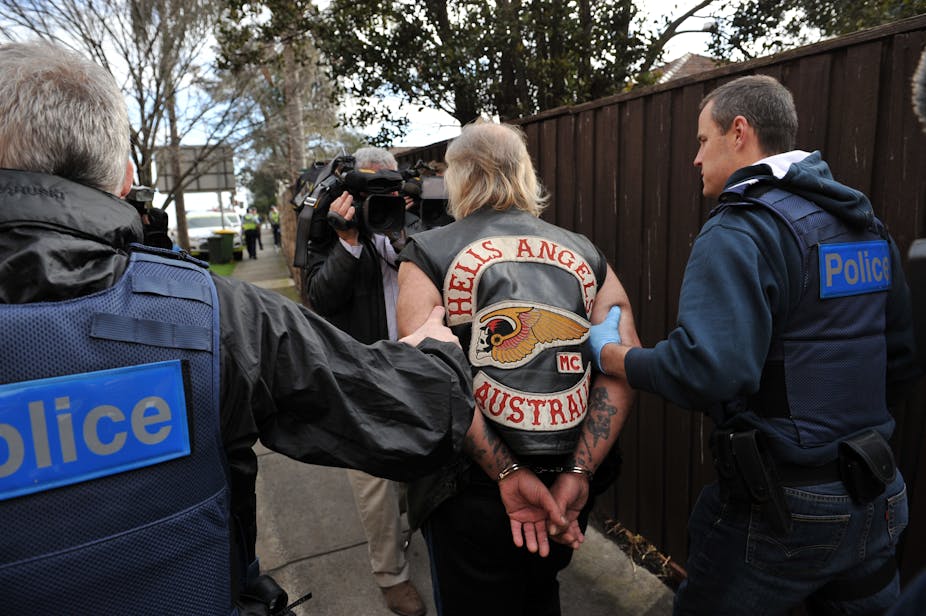A police officer meets someone in a bar, one thing leads to another and within a few weeks a relationship blossoms. The officer then discovers that the person’s brother is a known criminal.
Or an officer befriends someone at their local gym only to learn, after a few weeks spotting each other in the weights room, that they’re a bikie.
Should he or she report the relationship even if it is not yet directly related to their duties as an officer? Should he or she have to?
Given the job we entrust them to do, any police officer can find themselves in a situation which, while perhaps initially innocent enough, exposes them to risks of being compromised and corrupted.
In March, Victoria Police Chief Commissioner Ken Lay warned that outlaw motorcycle gangs were cultivating relationships with officers. This week news broke that informant and police identities have been leaked to an outlaw motorcycle gang.
While the scale of this particular leak is huge, leaks in general are all too familiar. On AFL Grand Final weekend in 2003 football wasn’t the only game being played in Melbourne. That weekend, files on police informant Terrence Hodson disappeared from the St Kilda drug squad offices. Hodson and his wife were subsequently murdered at their home in May 2004.
Files on another informant vanished from the same office during the 1996 Boxing Day test. John Higgs (a founder of the Black Uhlans motorcycle gang) is alleged to have bribed an officer to steal them. Higgs, who has since been convicted for drug trafficking, boasted of being tipped off about being under investigation, and has been linked to other high-profile cases of alleged murderers and drug traffickers being tipped off.

John Silvester suggests the most recent leaks reveal that though “veteran squad men beaten down by the system and lazy ones who were never any good” have always engaged in corruption, we’re now facing “drug-using coppers who will sell out their mates at the first opportunity”. But to understand the nature of corruption, we must look beyond the officers themselves, to the system as a whole.
There will always be bad apples, no matter the barrel or orchard they come from. But officers don’t have to be rotten to the core to end up corrupt.
In the 1970s, the New York Knapp Commission distinguished between two kinds of corruption. “Meat-eating” referred to the deliberate exploitation of power on a large scale. “Grass-eating” referred to accepting minor bribes or engage in other acts of relatively petty corruption or misconduct. This second kind was often normalised and rationalised by the behaviour of other officers and the culture of the organisation as a justifiable perk of the job.
Grass-eaters can be just as much a problem for a police force as meat-eaters, particularly as the former often mature into the latter when given the opportunity and/or after becoming cynical and jaded (both tend to occur when policing intractable problems like the market for illegal narcotics).
There will always be pressures to engage in grass-eating and opportunities for meat-eating (and a tendency for one to grow into the other). When we ask officers to enforce the law, we are asking them to routinely put themselves in harm’s way, not just physically, but ethically, because simply putting on the uniform exposes police to the risks of being corrupted. The cultivation of inappropriate relationships between officers and organised criminals, whether deliberate or incidental, is one source of that risk.
Criminal organisations have natural motives to ingratiate themselves with police and gain leverage over them. A common trend is to start small with gifts such as free drinks or entry to bars and nightclubs - things that are easier for an officer to accept and rationalise.
Once a relationship is established, the officer may be inclined to accept what is presented as a mutually beneficial exchange, or even just do a friend a favour. An officer may also, however, be put in a position where refusal is difficult, if not impossible. In either scenario, the integrity of the officer is compromised, and the consequences can be severe.
While leaks are just one possible outcome of inappropriate relationships (and the reasons for leaking are varied and complex) the results are clear. In the case of Hodson and in cases linked to Higgs, people lost their lives.

Chief Commissioner Lay is not overstating the problem when he describes the leaks as “one of the most serious types of corruption that could occur”. Leaks do lasting damage not just to individuals, but to the integrity and operational security of the whole organisation.
Unfortunately, corruption is not a problem that can ever be solved, but rather a threat that must be persistently fought. A focus on the risk of and opportunities for corruption to occur is fundamental.
In any workplace, an employer should protect employees exposed to toxic environments. In any organisation, employees have a responsibility to declare potential conflicts of interest.
Officers are already required to declare conflicts of interest when they arise (for example, if they are called to act on a matter involving someone with whom they have an association that may jeopardise their impartiality), and in some cases to formally register those conflicts of interest.
Can requiring officers to formally disclose any associations with criminals as potentially compromising relationships protect both the officer and the organisation as a whole from the risk of corruption?
Such a procedure can help the many officers of good integrity disclose the reasons for and context of such associations, insuring themselves against unwarranted suspicion.
It can also provide police with information on patterns of behaviour from officers at risk, better allowing the organisation to understand the way corrupting relationships develop and to protect their officers from it.

